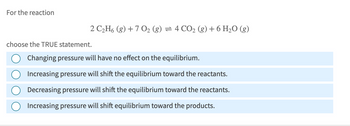
Chemistry: The Molecular Science
5th Edition
ISBN: 9781285199047
Author: John W. Moore, Conrad L. Stanitski
Publisher: Cengage Learning
expand_more
expand_more
format_list_bulleted
Question

Transcribed Image Text:For the reaction
choose the TRUE statement.
2 C2H6 (g) +7 O2 (g) = 4 CO2 (g) + 6 H₂O (g)
Changing pressure will have no effect on the equilibrium.
Increasing pressure will shift the equilibrium toward the reactants.
Decreasing pressure will shift the equilibrium toward the reactants.
Increasing pressure will shift equilibrium toward the products.
SAVE
AI-Generated Solution
info
AI-generated content may present inaccurate or offensive content that does not represent bartleby’s views.
Unlock instant AI solutions
Tap the button
to generate a solution
to generate a solution
Click the button to generate
a solution
a solution
Knowledge Booster
Similar questions
- . Explain what it means that a reaction has reached a state of chemical equilibrium. Explain why equilibrium is a dynamic state: Does a reaction really “stop” when the system reaches a state of equilibrium? Explain why, once a chemical system has reached equilibrium, the concentrations of all reactants remain constant with time. Why does this constancy of concentration not contradict our picture of equilibrium as being dynamic? What happens to the rates of the forward and reverse reactions as a system proceeds to equilibrium from a starting point where only reactants are present?arrow_forwardIn Section 13.1 of your text, it is mentioned that equilibrium is reached in a closed system. What is meant by the term closed system. and why is it necessary to have a closed system in order for a system to reach equilibrium? Explain why equilibrium is not reached in an open system.arrow_forwardExplain that equilibrium is dynamic, and that at equilibrium the forward and backward reaction rates are equal.arrow_forward
- For the generalized chemical reaction A(g)+B(g)C(g)+D(g) determine whether the concentration of D in an equilibrium mixture will (1) increase, (2) decrease, or (3) not change when each of the following changes is effected. a. concentration of A is increased b. concentration of B is decreased c. concentration of C is increased d. concentration of C is decreasedarrow_forwardIndicate whether or not each of the following changes would affect the value of a systems equilibrium constant. a. Addition of a product to the equilibrium mixture b. Increase in the systems total pressure c. Increase in the systems temperature d. Addition of both a reactant and a product to the equilibrium mixturearrow_forwardFor the generalized chemical reaction A(g)+B(g)C(g)+D(g) determine whether the concentration of A in an equilibrium mixture will (1) increase, (2) decrease, or (3) not change when each of the following changes is effected. a. concentration of B is increased b. concentration of C is decreased c. concentration of D is increased d. concentration of D is decreasedarrow_forward
- . Consider the following exothermic reaction at equilibrium: N2(g)+3H2(g)2NH3(g)Predict how the following changes affect the number of moles of each component of the system after equilibrium is re-established by completing the table. Complete the table with the terms increase, decrease, or no change. N2 H2 NH3 Add N2(g) Remove H2(g) Add NH3(g) Add Ne(g) (constant V) Increase the temperature Decrease the volume (constant T) Add a catalystarrow_forwardWrite equilibrium constant expressions for the following generalized reactions. a. 2X(g)+3Y(g)2Z(g) b. 2X(g)+3Y(s)2Z(g) c. 2X(s)+3Y(s)2Z(g) d. 2X(g)+3Y(g)2Z(s)arrow_forwardWrite a balanced chemical equation for a totally gaseous equilibrium system that would lead to the following equilibrium constant expression. Keq=[N2]2[H2O]6[NH3]4[O2]3arrow_forward
- Indicate whether or not each of the following changes would affect the value of a systems equilibrium constant. a. Removal of a reactant from the equilibrium mixture b. Decrease in the systems total pressure c. Decrease in the systems temperature d. Addition of a catalyst to the equilibrium mixturearrow_forwardThe value of the equilibrium constant, K, is dependent on which of the following? (There may be more than one answer.) a. the initial concentrations of the reactants b. the initial concentrations of the products c. the temperature of the system d. the nature of the reactants and products Explain.arrow_forwardConsider the following equilibrium system. N2(g)+O2(g)2NO(g) a. Write the chemical equation for the forward reaction. b. Write the chemical equation for the reverse reaction.arrow_forward
arrow_back_ios
SEE MORE QUESTIONS
arrow_forward_ios
Recommended textbooks for you
 Chemistry: The Molecular ScienceChemistryISBN:9781285199047Author:John W. Moore, Conrad L. StanitskiPublisher:Cengage Learning
Chemistry: The Molecular ScienceChemistryISBN:9781285199047Author:John W. Moore, Conrad L. StanitskiPublisher:Cengage Learning World of Chemistry, 3rd editionChemistryISBN:9781133109655Author:Steven S. Zumdahl, Susan L. Zumdahl, Donald J. DeCostePublisher:Brooks / Cole / Cengage Learning
World of Chemistry, 3rd editionChemistryISBN:9781133109655Author:Steven S. Zumdahl, Susan L. Zumdahl, Donald J. DeCostePublisher:Brooks / Cole / Cengage Learning Introductory Chemistry: A FoundationChemistryISBN:9781285199030Author:Steven S. Zumdahl, Donald J. DeCostePublisher:Cengage Learning
Introductory Chemistry: A FoundationChemistryISBN:9781285199030Author:Steven S. Zumdahl, Donald J. DeCostePublisher:Cengage Learning Introductory Chemistry: A FoundationChemistryISBN:9781337399425Author:Steven S. Zumdahl, Donald J. DeCostePublisher:Cengage Learning
Introductory Chemistry: A FoundationChemistryISBN:9781337399425Author:Steven S. Zumdahl, Donald J. DeCostePublisher:Cengage Learning Living By Chemistry: First Edition TextbookChemistryISBN:9781559539418Author:Angelica StacyPublisher:MAC HIGHER
Living By Chemistry: First Edition TextbookChemistryISBN:9781559539418Author:Angelica StacyPublisher:MAC HIGHER

Chemistry: The Molecular Science
Chemistry
ISBN:9781285199047
Author:John W. Moore, Conrad L. Stanitski
Publisher:Cengage Learning

World of Chemistry, 3rd edition
Chemistry
ISBN:9781133109655
Author:Steven S. Zumdahl, Susan L. Zumdahl, Donald J. DeCoste
Publisher:Brooks / Cole / Cengage Learning

Introductory Chemistry: A Foundation
Chemistry
ISBN:9781285199030
Author:Steven S. Zumdahl, Donald J. DeCoste
Publisher:Cengage Learning

Introductory Chemistry: A Foundation
Chemistry
ISBN:9781337399425
Author:Steven S. Zumdahl, Donald J. DeCoste
Publisher:Cengage Learning


Living By Chemistry: First Edition Textbook
Chemistry
ISBN:9781559539418
Author:Angelica Stacy
Publisher:MAC HIGHER